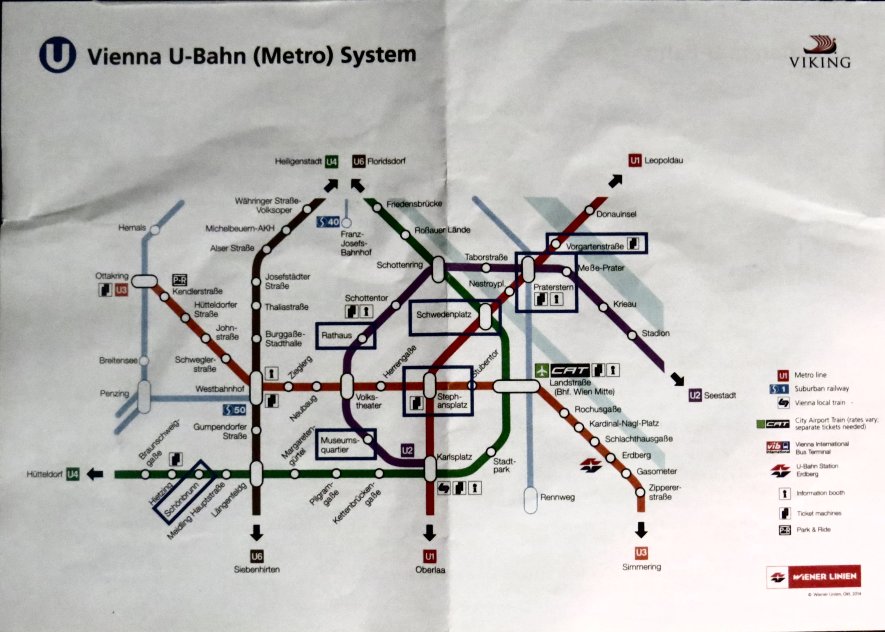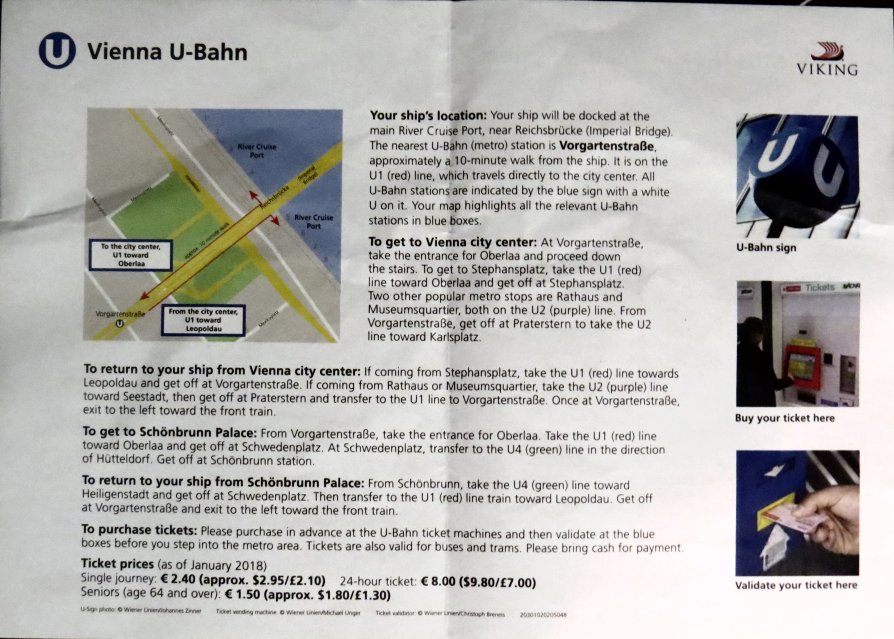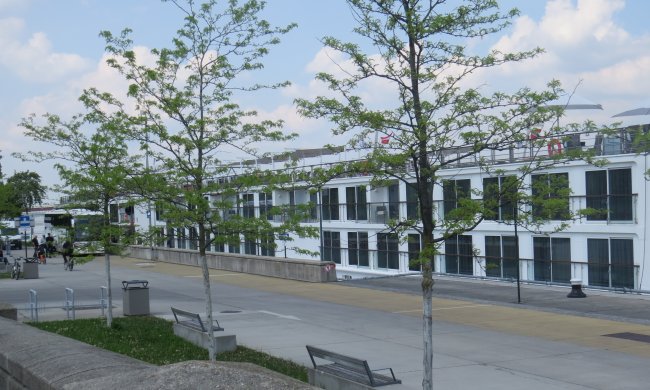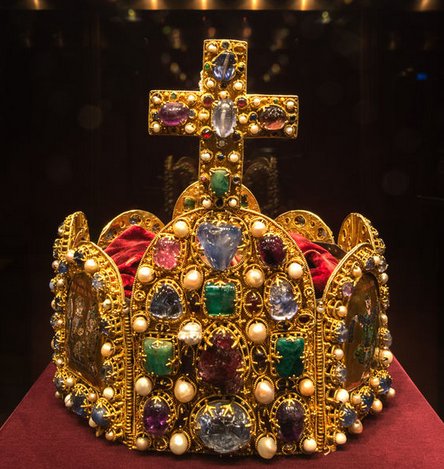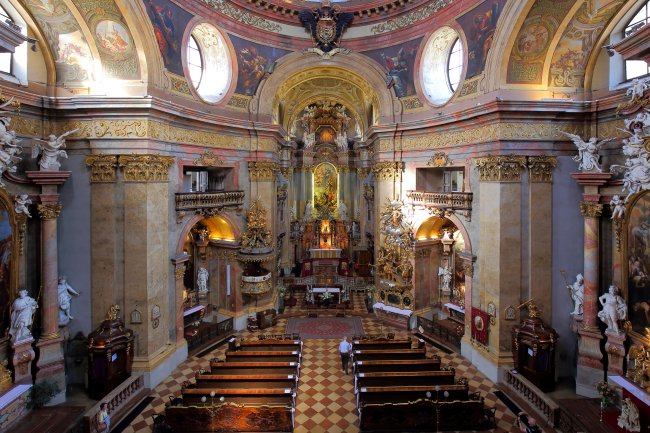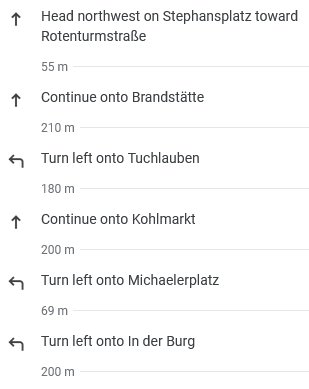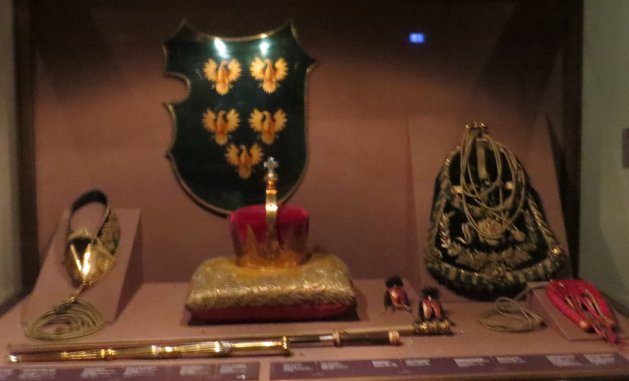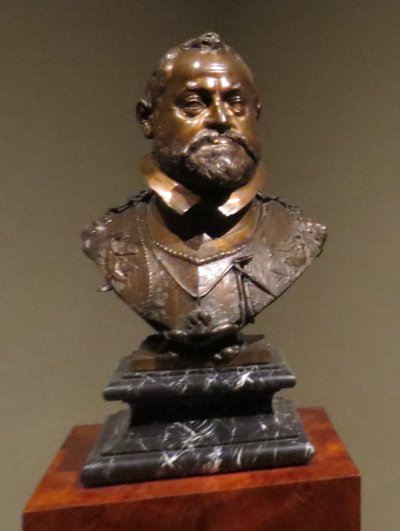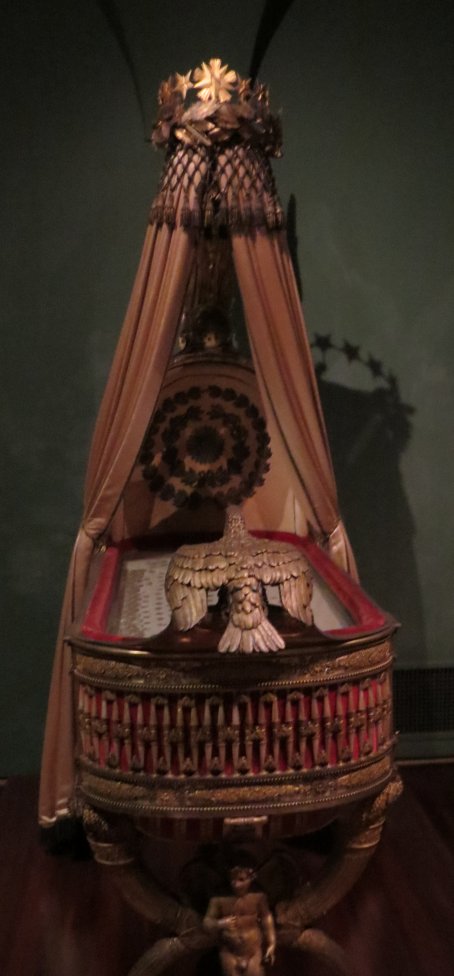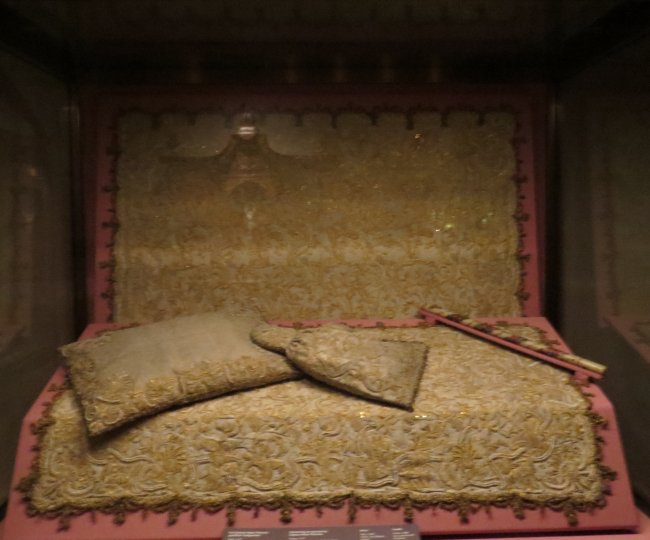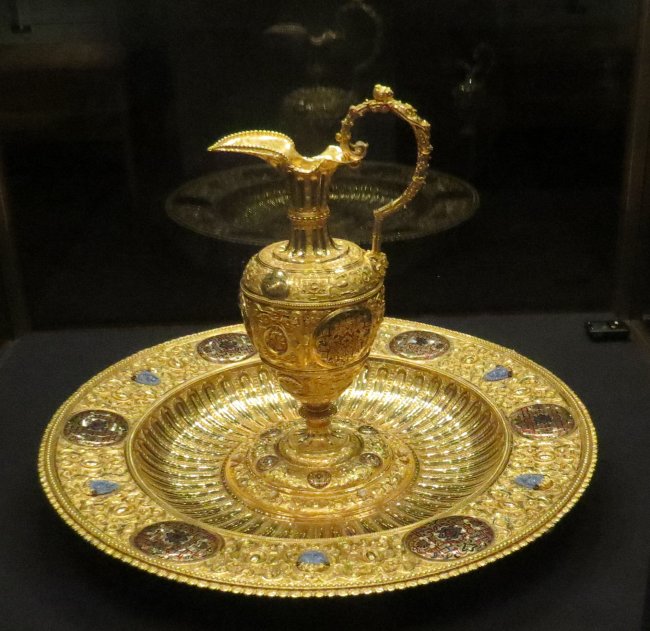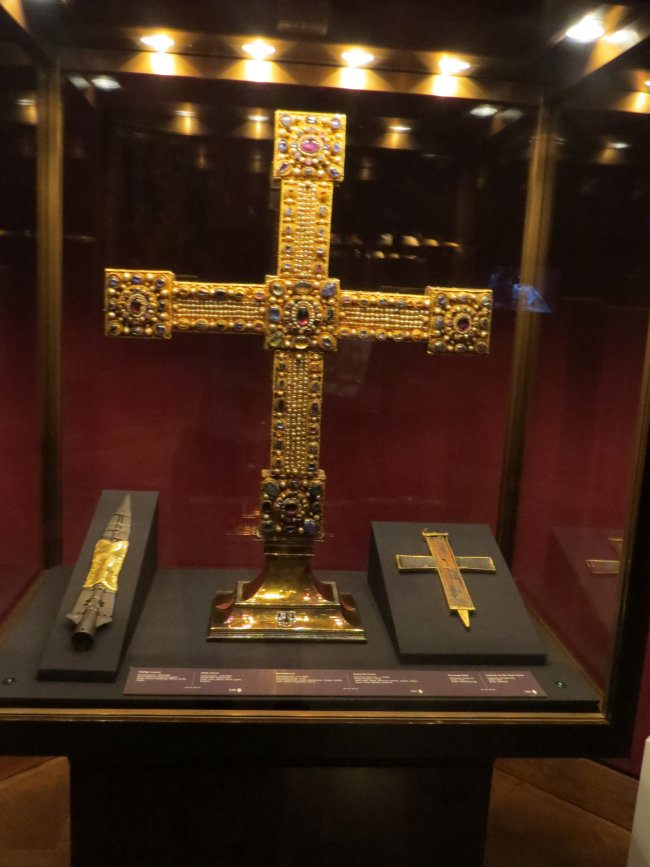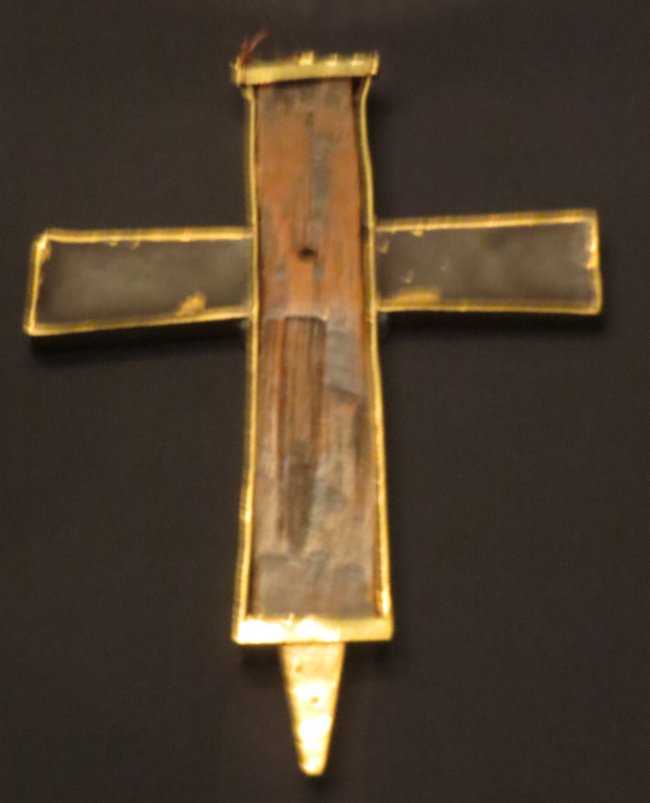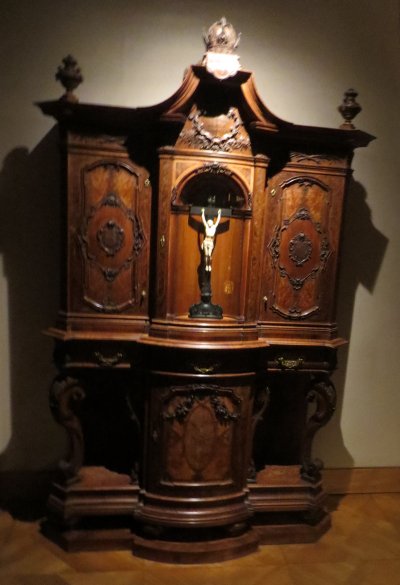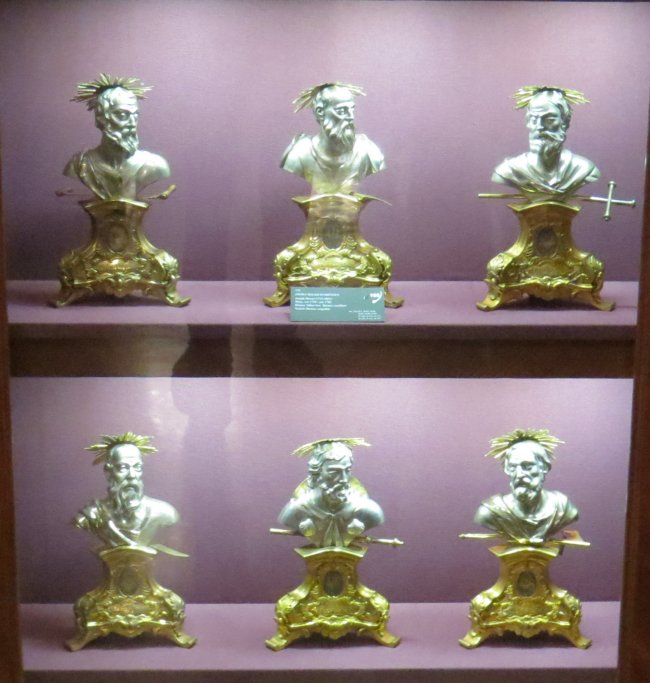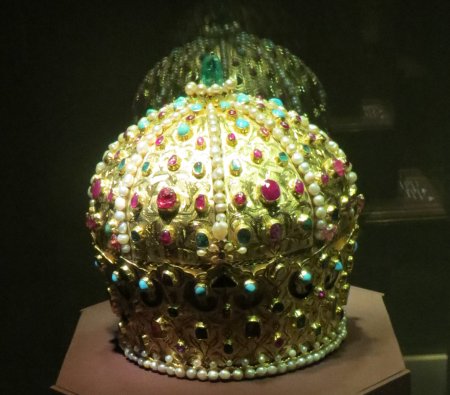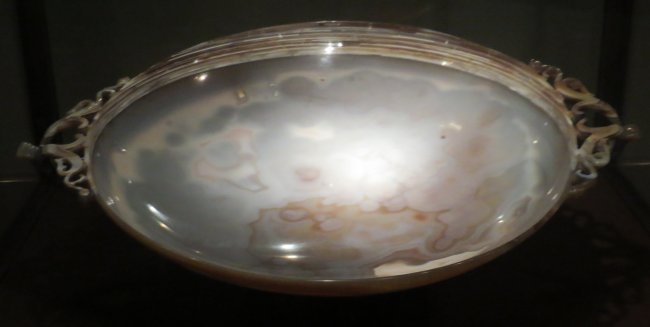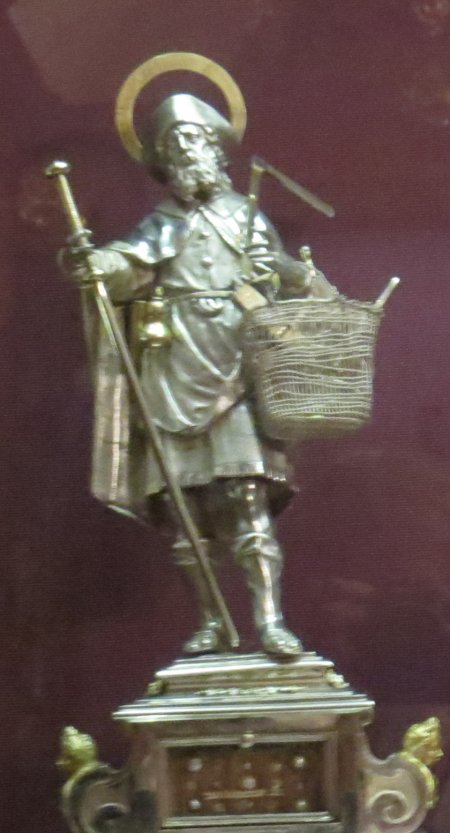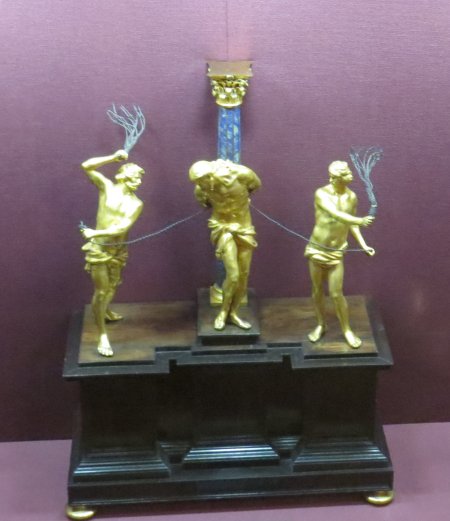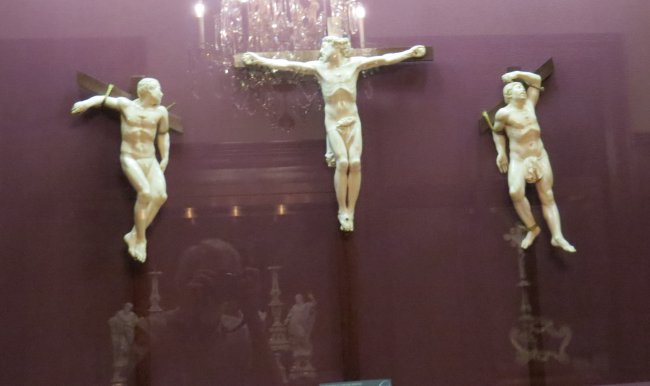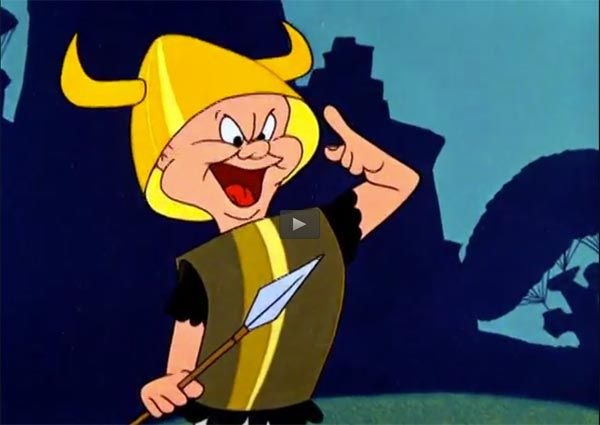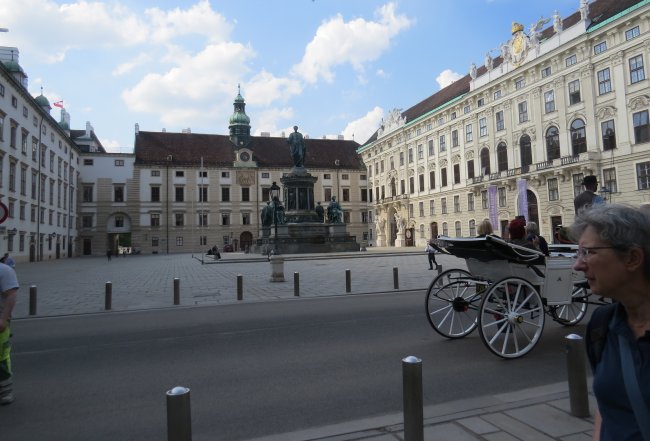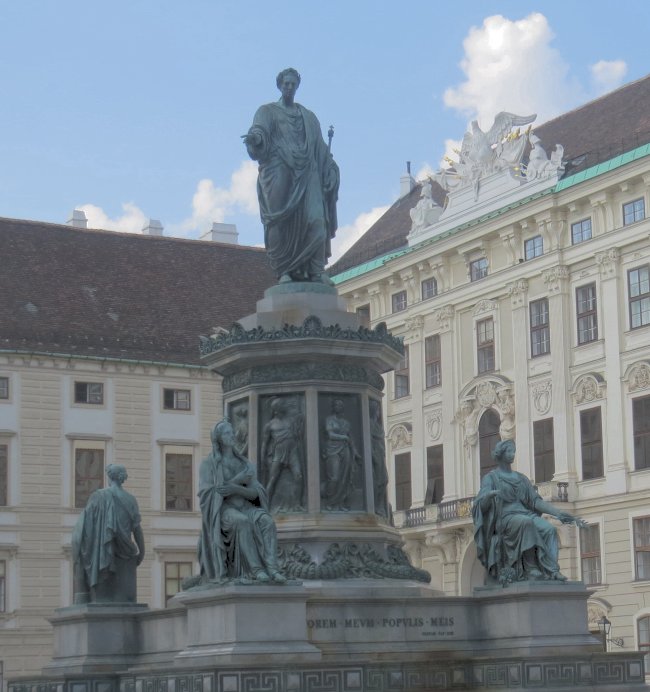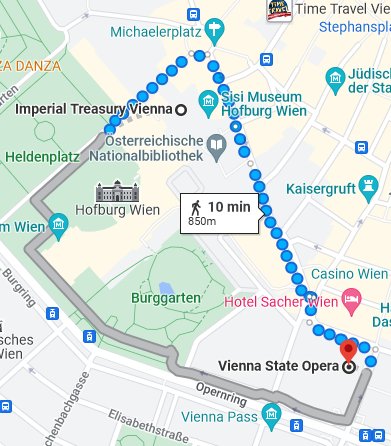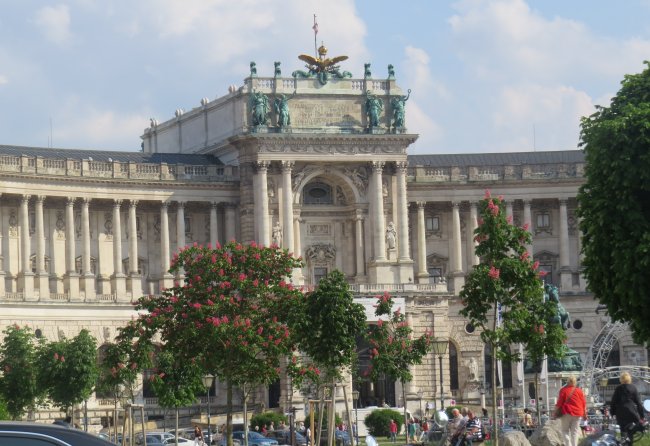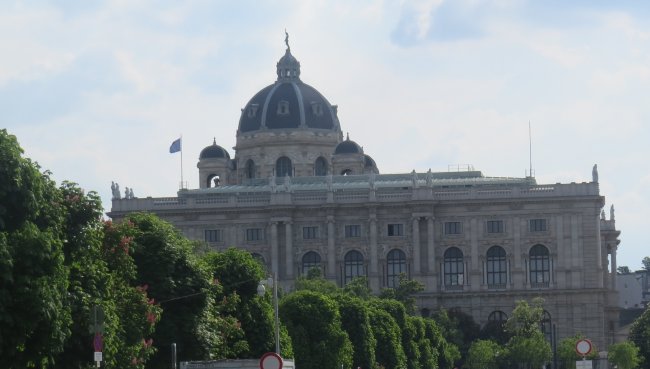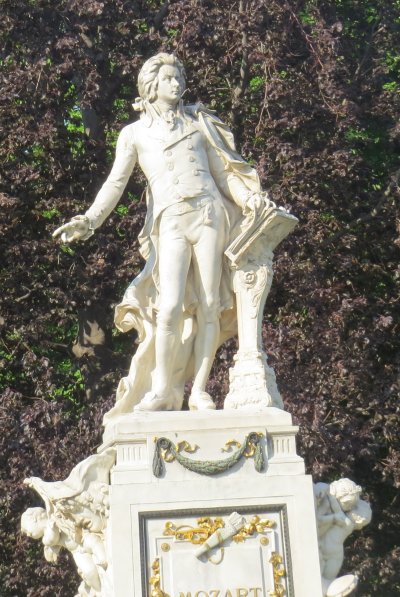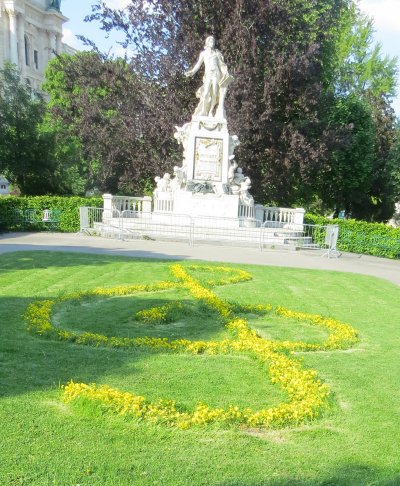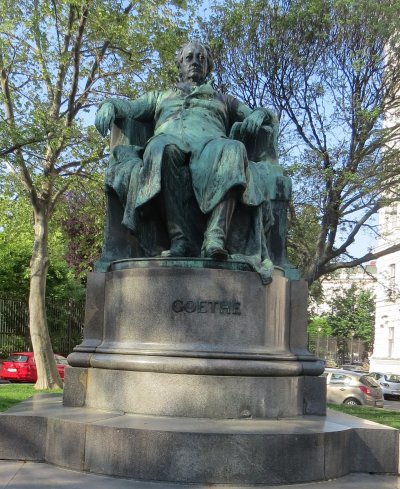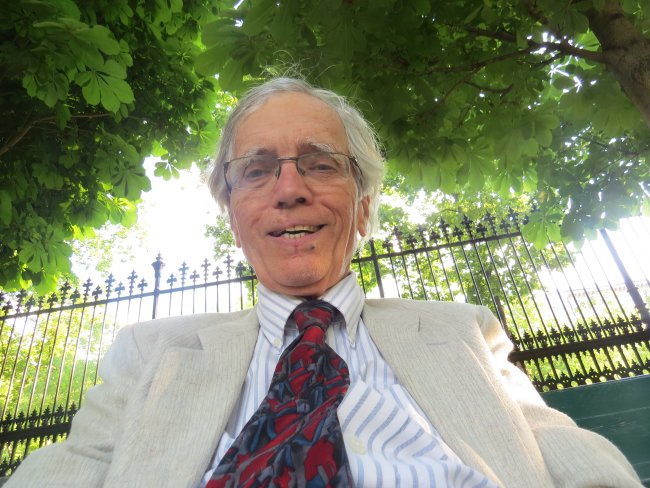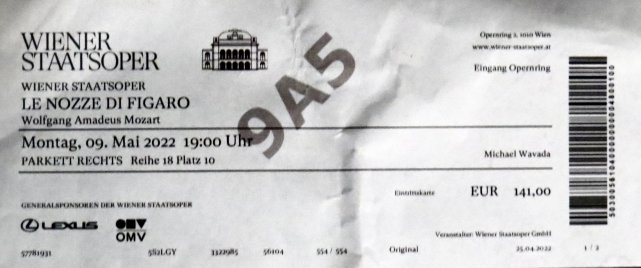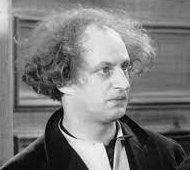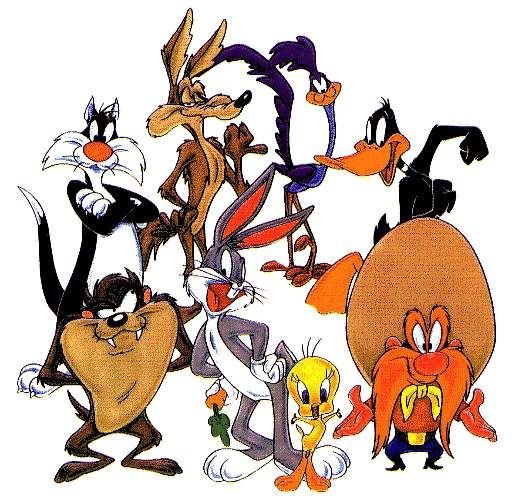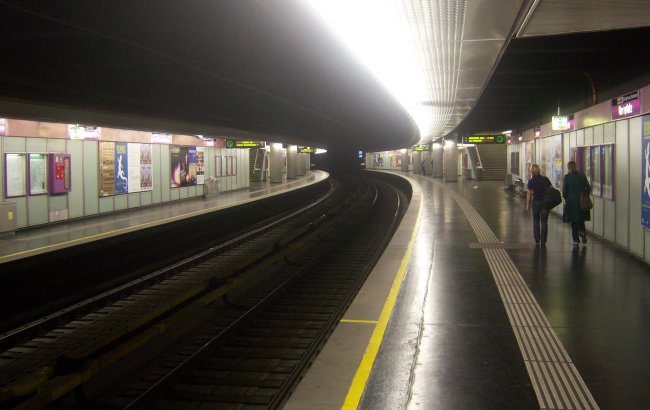Before the excursion: At a little after 3 o'clock in the morning I received a telephone call from Sue. She was not expecting me to answer, and, in retrospect, I wish that I had not.[1] She wanted to make sure that I had received the information about the change in the tickets. It took me five or ten minutes to assure her that I had and that I really needed to get some sleep.
My plan for the day had three important items: (1) The "Panoramic" tour of Vienna, which was offered free of charge; (2) The self-led tour of the Imperial Treasury, for which I had downloaded a ticket onto my cellphone; (3) The opera, for which I had two printed tickets.
The only remarkable thing about breakfast that morning was that there were no bananas available. In fact, I never saw a banana for the rest of the journey.
After breakfast I asked at the desk about walking to the U-Bahn station. The lady on duty gave me a two-sided map that explained a lot, but it did not tell where the ship was docked and how to get from where we were to the station on foot. She said that that was easy—you could go up or go under. I figured that it would be fairly obvious when I got on land. I should have asked how to return to the ship, which was not as easy, especially in the dark.
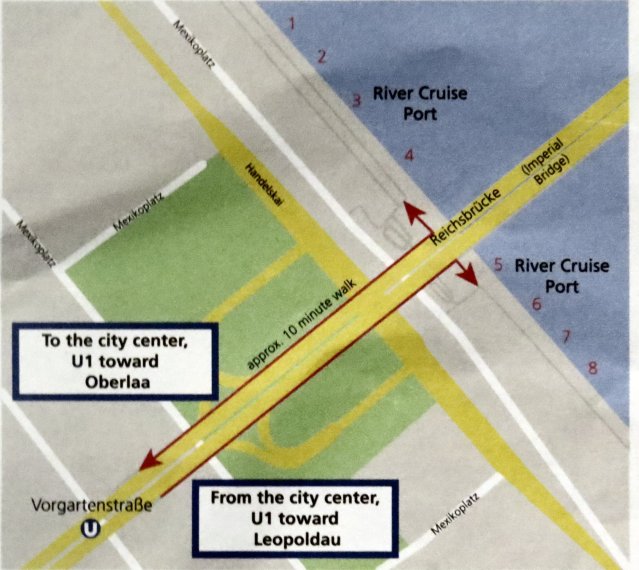
The key thing for me to remember was to take the red-line train marked "Leopoldau" on the way out and the one marked "Oberlaa" on the way back. I was fairly confident of my ability to deal with the U-Bahn.
The weather was, if anything, even more spectacular than it had been on the previous three days. The high temperature was in the low seventies Fahrenheit.
The Panoramic Vienna excursion: The excursion, which departed at 9 a.m., was, for me, mostly a bust. I had not slept well the previous night, and that surely contributed to my lack of preparedness. The digital recorder that should have been in my pocket was instead lying on the counter in my stateroom. I did remember to bring my camera this time, but I had forgotten to change the battery. A fully charged battery also rested comfortably on the counter near the recorder. I snapped only four photos with the Canon before the battery ran out. I had brought my cellphone and took a few photos with it, but I did not take the time to send them to my laptop. I figured (incorrectly) that I would be able to do that later.
I really had done a poor job of gathering together my equipment for the excursion. On previous trips I had kept everything in my backpack (or, as they say in Europe, “rucksack”). I had determined that I did not need it for day-to-day activities on this cruise. So, the account of this excursion relies on my seventy-three-year-old memory and a few notes that I made after the excursion ended.Our guide for the excursion was named Frederick Louis. His French mother supplied the middle name, which he pronounced like "Louie". He enlivened his presentation with a number of quite humorous stories, but he ended each one by laughing at his own jokes in the same way that Gary the Program Director did. It got on my nerves. To be fair, however, at this stage practically everything was getting on my nerves.
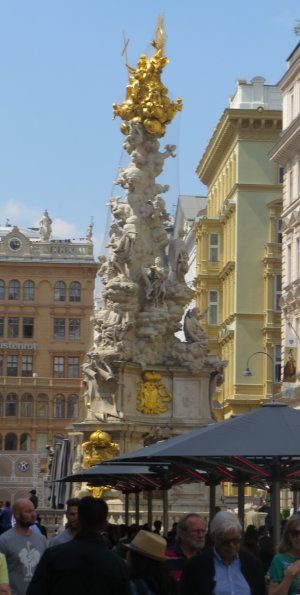
The first part of the excursion brought to mind the bus ride in Budapest. Traffic was quite heavy. Frederick pointed out a few things, but most were difficult to see, much less photograph.
I learned as much about the river as I did about the city. The German name for the river was Donau (DOE now). Three streams bore that name in Vienna—the Old Danube, the New Danube, and the Danube canal. We were docked under the Reichsbrücke bridge on the Old Danube, which was divided by the 22-mile long Danube Island from the New Danube. The Danube Canal supplied the city's drinking water. The New Danube was a public recreation area.
Fortunately, the busing phase of the excursion only lasted for a half hour or so. The driver pulled the bus over somewhere in the central city. I wished at that point that I had brought my map with me. Throughout the tour I had trouble orienting myself. I am not sure where we stopped, but it must have been fairly close to the Hofburg Palace.
From my perspective the most important thing that Frederick provided for us was a glimpse of where the Imperial Treasure museum was. It was really well hidden. I tried to imprint its location precisely in my memory. I was not up to the task, but I was pretty sure that I would recognize the small sign in a small courtyard that marked the entrance. I took a photo of the sign with my cellphone.
Frederick talked quite a bit about the museum. He said that the two big attractions were the crown of the Holy Roman Emperors and the Holy Lance. He said that the lance dated back to Carolingian times, which meant around 800 AD. If so, it seemed unlikely to me that it could be whatever Peter Bartholomew dug up during the siege of Antioch in the First Crusade in 1098. I wrote extensively about that event and its aftermath here.
Frederick recommended visiting this museum. He did not mention that at the time that we were in Vienna the crown was not on display. He probably did not know.
We walked past the building in which the Lipizzaner stallions for the Spanish Riding School were stabled. I took a few photos of the horses with my cellphone.
The tour ended with us walking down a wide pedestrian-only thoroughfare called the Graben to Stephansplatz. At that point Frederick told us that we had about thirty minutes of free time to explore. The cathedral of St. Stephan is, of course, the main attraction of the area. Frederick also showed us the location of Peterskirche, a smaller church that was nearby.
I spend the first part of the free time walking on side streets in search of an ATM. I found one rather quickly. I withdrew €50 and then started looking for a store that might sell some of the items that I had forgotten to pack for the cruise—a comb, fingernail clippers, and some over-the-county medical stuff. Walgreens and CVS, which both have two stores in Enfield, sell everything that I needed. However, although I walked up several blocks in several directions, I found nothing with any promise. Restaurants and high-end retailers abounded, but tourist-oriented locations like Vienna's Old Town seldom had places devoted to meeting day-to-day needs.
I don't remember entering the cathedral at all. I did stop in for a few minutes at Peterskirche. It was extremely ornate. If I had had my camera, I would have taken quite a few photos.
The church was now owned by Opus Dei, a very conservative order of Roman Catholic priests. I did not realize that while I was there. I picked up a card describing (in German of course) the deeds of Josemaría Escrivá, the founder of the controversial order. I kept it for a while, but I could not locate it when I composed this journal more than a month later.
I located the U-Bahn station near the cathedral. I planned to emerge there when I took the subway after lunch.
I arrived at the designated meeting spot about ten minutes early. I was happy to find a bench to sit on. It was actually becoming a little bit warm. Frederick arrived to lead us to the location designated for the bus to pick us up and transport us back to the ship. A fairly large portion of our group remained in the central city.
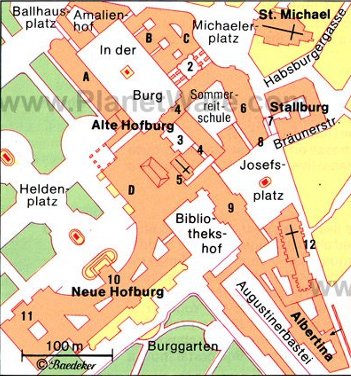
Lunch and preparation: I keyed in some notes on my laptop about what I learned in the morning excursion. I went to the restaurant as soon as it opened at 12:30. I was happy to sit by myself and pore over Rick Steves' write-up of the Imperial Treasury while I enjoyed some very tasty baby back ribs and several glasses of iced tea. I had also taken screen-shots on my laptop of Google Maps' description of the walk from Stephansplatz to the museum, but there was no way for me to print a copy.[2]
At some point Ria Lopez, the maitre d' who always called me "Sir Michael" entered the restaurant with a tray full of small glasses containing a light yellow liquid. She asked me and everyone else if we wanted a banana smoothie. I declined, but I overheard a woman at the next table remark, "Well, that's one way to get rid of overripe bananas that no one will eat."
I planned not to return to the ship after the visit to the Treasury. I therefore changed into my black trousers, socks, and shoes. The shirt that I wore on the excursion was reasonably dressy. This time I was careful to pack everything that I needed into my backpack—my sports coat and tie for the opera, my camera, a street map of Vienna, and Rick Steves' guidebook. My wallet, cellphone, and recorder were in my pockets.
I knew from the morning excursion where the Viking Vili was docked. I scanned out of the ship and walked toward the bridge that spanned the Danube. On the other side of the street that ran along the dock was a small park. Some stairs there led up to street level. I located the U-Bahn station without any difficulty.
I found the U-Bahn very easy to use. I walked up to the machine that sold tickets. I actually could have ridden for free in one of two ways: (1) by just getting on the trains; no one checked the tickets; or (2) by using one of the three tickets that someone left on the machine from which I had already purchased two more tickets. All the tickets were the same price. For some reason this lackadaisical enforcement system seemed to work in Europe.
After a few minutes the train arrived. Stephansplatz was the fourth stop. I exited the train, walked up the stairs, and found myself exactly where I expected to be. Now what?
There were two problems with the instructions that Google Maps had provided. In the first place most European cities do not have street signs. Signs with the names of the streets are sometimes—but not always—affixed to buildings on the corners. I saw few if any of the names that were on the directions.
The other problem was that In der Burg was not a street, and it was not directly connected to any street. To get there one must go through a building, and the signage was meager at best. When the day was over I wrote that if I had not brought the Rick Steves Vienna book, I would never have found the museum.[3] As it was, I had to double back a couple of times. Even after I found Michaelerplatz I had a difficult time figuring out how to reach In der Borg, and once I arrived there the passage to the other courtyard was not immediately obvious.
The Imperial Treasury: There was no line at the ticket booth for the museum. I could have just bought a ticket then and there. The lady selling tickets warned me that the imperial crown of the Holy Roman Emperor was not on display. That was a slight disappointment, but I did not come to Austria to look at a royal hat, even if it was over 1,000 years old. She had a hard time figuring out how to handle my electronic ticket. Another lady there showed her how to process it.
I asked about obtaining an audio guide, but she was not directly responsive. For some reason she seemed reluctant to rent me one. Maybe she thought that I was claiming that my ticket included the cost of the guide, or maybe the museum was not issuing them because of Covid-19. I did not press the issue.
From the ticket counter I had to climb some stairs to reach the area of the museum that included restrooms and a place to check the backpack. As I turned toward them the lady asked me if I wanted to take the elevator. I must have looked much more decrepit than I felt.
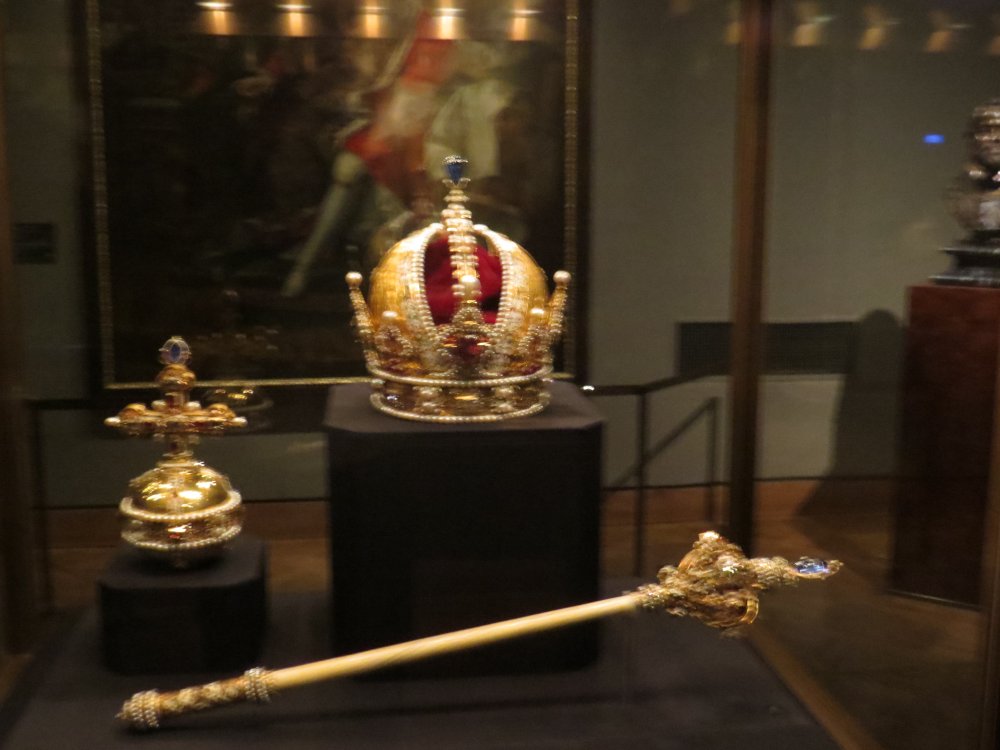
The museum was interesting despite the fact that the HRE's spectacular crown had indeed been checked out by scholars who were researching something about it. There were actually two empires involved here. The so-called Holy Roman Empire began in 800 when Pope Leo III surprised Charlemagne by presenting him with a crown in Rome. That empire lasted for more than one thousand years. In order to prevent Napoleon from claiming the title Emperor Franz II dissolved it in 1806. Thereafter he called himself Franz I, Emperor of Austria. This empire lasted, in one form or another, until the end of World War I, when the monarchy was abolished.
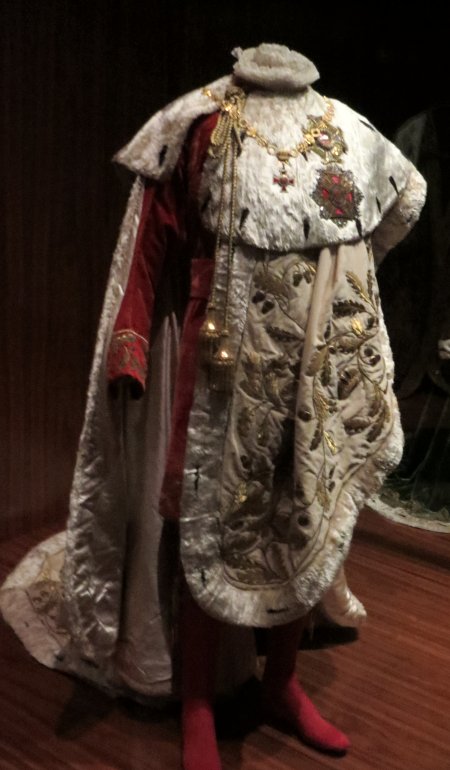
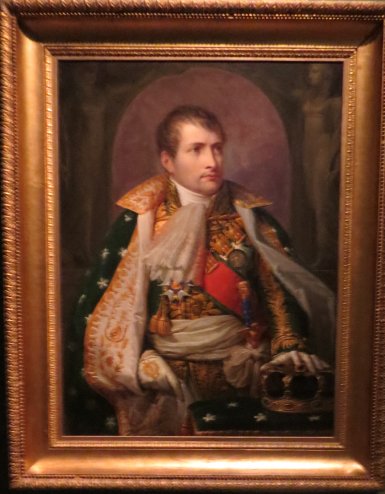
My research had indicated that my primary objective, the Holy Lance, and many other noteworthy objects were in room #11. I wandered around the other rooms taking photos whenever something struck my fancy. I was surprised to find a painting of Napoleon with a wispy mustache and a cradle used by Napoleon's son.
Finally I came upon room #11. The showcase that usually contained the HRE crown was in the center of the room. It contained a life-sized photo of the missing crown. The lance shared a showcase with a couple of crosses. The only written material about the lance was a small card that read:
Holy Lance
Carolingian (750-800)
(with later additions)
steel, iron, brass, gold, silver, leather
The smaller "cross" was actually a reliquary for a large piece of wood that was allegedly part of the "True Cross" of Jesus's crucifixion. The other cross had two secret compartments to contain the reliquary and the lance, which was also reported to include materials from a nail used at the crucifixion.
A group of students, approximately of high-school age, came into room #11 while I was there. Their leader (speaking in German) asked them to gather around the case that contained the lance. He talked to them for five or ten minutes. The students listened attentively. When he finished they all applauded and then left the room.
What is the fascination with the Holy Lance? The story is complicated. In the first place there are three ancient events that reportedly involve holiness and lances.
- The Gospel according to John (and none of the others[5]) describes a Roman soldier piercing the side of Jesus with a lance to see if he was dead. Over the centuries the name Longinus was eventually given to the soldier, he was promoted to centurion, and several conflicting stories were eventually spread about him. The story became so popular that in many places Longinus has for centuries been considered a saint. The basic reasoning was that all people who came in close personal contact with Jesus were so overwhelmed by the experience that they converted on the spot.
- The Egyptian native St. Maurice was also a Roman soldier, reportedly in the second half of the third century. Over the centuries many legends also developed about him and his deeds. Some of these stories involved a lance.
- Peter Bartholomew was involved in the First Crusade at the end of the eleventh century. He was in Antioch when the city was besieged by the Seljuk Turks. He asserted that St. Andrew had disclosed to him the location of the head of Longinus's lance, which may or may not have also been Maurice's legendary weapon. Shortly thereafter PB went to a church in Antioch and produced it from the floor. There is reasonably good historical evidence that this "lance" (described as "lump of iron") was used as a standard of the Christian troops thereafter in one successful battle after another. What became of it after the decisive victory in Jerusalem is open to speculation.[6] PB was long dead by then.
So, there may be as many as three Holy Lances, two used by people who may or may not be saints. The holiness of the third lance derives less from its association with Peter Bartholomew and its provenance than its proven effectiveness as a standard for Christians fighting a sacred crusade called by His Holiness, Pope Urban II.
It seems unlikely to me that the Holy Lance is any of the three above. It is not old enough to be one of the first two, and what are the chances that Peter Bartholomew got his hands on a 300-year-old piece of metal? Besides, PB's lance was just a lump of iron. The Hofburg item is a work of art or at least craftsmanship.
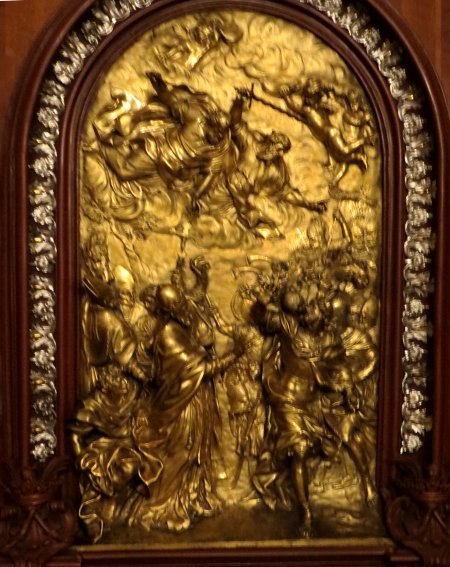
Still, many famous people have thought highly of the Holy Lance, also sometimes called the Spear of Destiny. Napoleon coveted it; Hitler seized it and moved it back to Nuremberg; Wagner wrote a long tiresome opera, Parsifal, about it; Elmer Fudd sang beautifully about it and a Magic Helmet in one of the most famous cartoons of all time, "What's Opera, Doc?"
Incidentally, at least three other sites claim to have all or part of the Holy Lance—St. Peter's in Rome (never on display), Vagharshapat in Armenia, and Krakow. Paris also claimed to have the tip of the lance, but it was lost around the time of the French Revolution.
After I left room #11, I went to the small store that was associated with the museum. I was hoping to find a book there that might provide more detailed information about the exhibits. The books contained mostly pictures, and what little text they provided was almost exclusively in German. I left disappointed.
From the Treasury to the Opera: I then went back through both courtyards, where I took a few photos. I knew from what Frederick had told us that the large statue of a man wearing what appeared to be Roman garments must have been one of the Holy Roman Emperors. Frederick had also doubtless told us his name, but I did not remember it. I had to scour the Internet to determine that it was Franz II, the last Holy Roman Emperor.
I then departed from the grounds of the Hofburg Palace. The southeast end of the palace was very close to the opera house. However, I had to exit on the far north end of the palace. From there I faced a trek of at least half of a mile. I chose to walk the verdant route that was shown in grey on the Google Map at the left.
Plenty of time remained before the beginning of the opera, and I was not hungry. So, I set an easy pace and soon discovered a shady place to sit and do some people-watching. Since I had no way of taking notes, I described one very odd occurrence to my digital recorder.
This was one of the rare occasions on which I allowed myself to appreciate the ambiance of the location. The people were almost uniformly disturbingly young. They looked fit and happy.
After a fairly lengthy respite I resumed my stroll toward the Ringstrasse. The Natural History Museum was visible across the street when I turned left onto the Burgring. Upon arriving at the Burggarten I snapped a few photos of Mozart's statue and the treble clef that lay at his feet, as it should. The prospect of lingering there was tempting, but I wanted to be certain of my plans for the rest of the day.
So, I continued my trek past the statue of Goethe. The opera house itself was quite physically imposing. I recalled the story that Frederick had told us in the morning excursion. The opera house was designed by Eduard van der Nüll and August Sicard von Sicardsburg, who won a contest for the honor. Emperor Franz Josef and much of the Viennese press did not like the finished product and said so vehemently. Eduard hanged himself on April 4, 1868. His friend August died ten weeks later. Frederick said that the cause was a heart attack; Wikipedia says that it was tuberculosis. Maybe tuberculosis gave him a heart attack.
It was still much too early to try to enter the opera house. I thought about walking down one of the nearby streets in search of a casual restaurant. I saw a sign indicating that there was a McDonald's nearby. However, I wasn't really hungry. I decided to return to the Burggarten to rest in the shade. I had noticed that a small stand or perhaps a food truck sold food and beverages near there. Before I returned to the park, however, I made sure that I knew where the U-Bahn station was.
Nothing sold in the stand by the Burggarten appealed to me except the beverages. I bought a bottle of Diet Coke, which was called Coke Light in Europe. It was nice and cold, and I hoped that the caffeine could me awake through the end of the performance.
The park was a delightful place to spend some time. I found a bench in the shade. I put on my tie and sports coat and took a photo of myself. Although it was exceptionally easy to take a "selfie" with the Canon, I am pretty sure that this was only the second time I had ever done so.
Just the right number of people were relaxing in the park—enough so that something interesting was usually going on, but not so many that it felt crowded. I did not take photos of anyone or anything because it seemed too intrusive. Some of the people were sunbathing in the unseasonable heat of early May.
At a few minutes after six I put my camera in my backpack and my tickets in my pocket. I then hiked back to the opera house. I found a seat on a concrete bench and tried to determine when it would be fashionable for me to make my entrance. I noticed a fellow who seemed to be approaching people discretely. I suspected that he was selling tickets. This was, I think, the Viennese version of the "Who needs four?" approach of the obstreperous scalpers at Fenway Park.
In fact, I had Sue's ticket in my pocket, and I considered trying to sell it. I decided against it for two reasons: 1) I would be forced to sit next to whoever purchased it; 2) If it was illegal to resell the ticket, I might get in trouble and miss the ship. Besides, I imagine that these exchanges involved haggling, which I have always detested even when both parties spoke English.
At about 6:40 I decided to go inside. I easily found the box office. One of the ushers then told me where I could check my backpack, which contained my camera but not my digital recorder. I then made my way to my seat which was in the last row on the floor almost precisely in the center. There was an aisle that descended seventeen rows from the two seats on my left. So, those two seats had a clear view of the stage. However, the device that displayed the words being sung (in German, English, Italian, Russian, French, or Japanese) for those two seats had to be held to be used. Mine was attached to the seat in front of me.
I knew that the seat to my right would be empty; I still had that ticket in my pocket. Eventually the seat to my left was taken by a rather attractive young (for someone attending an opera) lady who, like me, seemed to be alone. I composed in my mind how to describe her to Sue. I settled on "... was attractive enough, but much too old for me. She'll certainly never see thirty again." Later I came up with the idea of admitting that "Yes, she was probably young enough to be my granddaughter, but she was definitely too old to be my great granddaughter."
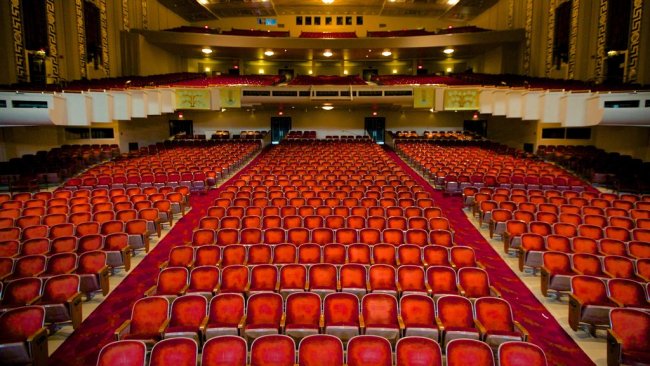
I was a little surprised at the size of the auditorium. It was larger than the opera house in Prague, but that establishment was largely tourist-oriented; it was not designed for the emperor's use. The capacity seemed much less than the Met's. It seemed more like the Bushnell, except for the many rows of box seats along the sides.[7]
Before I took my seat I probably should have bought a program. I still have the one from the performance of Don Pasquale that Sue and I attended in Rome in 2003. That program included a complete libretto.
The audience was much younger than what I had expected from performances that I had attended in the United States. The mood seemed somewhat festive. Several groups of five or more were evident. Many people used their phones to photograph one another or the interior.
I played around with the "subtitle and information system" that was attached to the back of the seat in front of me. I set it for English. It made it quite clear that photography was not allowed inside the theater, but it mentioned nothing about audio recordings.
I did a pretty good job of hitting the midpoint in terms of dressiness. I doubted that anyone had noted that my black shoes were actually sneakers with leather tops. Quite a few men were wearing suits, but, then again, there were plenty of guys without ties. I saw no tuxedos. As usual, almost all the women were dressed to kill, but I saw a few in slacks. I only noticed one obvious transvestite.
For a while it appeared that no one would sit in the two seats in front of me, but at just before seven o'clock a couple arrived. The orchestra section (including my section, which was called Parkett) appeared to be about three-fourths full, but at least five seats to my right were empty. The couple barely had time to get seated before ...
Le Nozze di Figaro and the return to the ship: ... the lights dimmed, and the orchestra began the familiar strains from the overture that never seemed to get old. No matter how many times I hear this opera (I certainly have listened to it more than one hundred times) I still get a little thrill when I hear:
The conductor for this performance was Adam Fischer. The singers were:
| Count Almaviva | Michael Nagy |
| Countess | Maria Bengtsson |
| Figaro | Peter Kellner |
| Cherubino | Isabel Signoret |
| Marcellina | Stephanie Houtzeel |
| Doctor Bartolo | Wolfgang Bankl |
| Barbarina | Joanna Kedzior |
| Antonio | Hans Peter Kammerer |
| Susanna | Regula Mühlemann |
| Don Basilio | Robert Bartneck |
| Don Curzio | Andrea Giovannini |
I was familiar with neither the singers nor the conductor. The performers all seemed young to me, even the ones who played Doctor Bartolo and Marcellina, who were meant to be a generation older than Figaro and Susanna. No performance seemed truly exceptional, but this was an ensemble piece, and this cast seemed to work well together.
I was happy that they used a traditional production without trying to modernize it. I must say, however, that the best performance that I have seen was a recent one at the Met that was set in the 1920's. The production that Sue and I attended in Prague in 2007, however, tried to weave some golf clubs into the plot. Mozart and Da Ponte did not need that kind of help.
I enjoyed the opera, especially the first two acts while I was still alert and attentive. What I liked least was the posture and hairdo of the guy seated in front of me. He was not exceptionally tall, but he sat upright. He had little if any hair on the top of his head, but it was bushy on the sides. It wasn't as noticeable as Larry Fine's, but it was enough that I had to lean to my left to see the right side of the stage. If I moved to the seat on my right I would have had trouble seeing the left side of the stage. Don't get me wrong. It was not a major issue. I knew the story like the back of my hand.
I wasn't too impressed by the rendition of Doctor Batolo's aria in the first act, but all of the other performances were fine. As in every other performance that I have witnessed, the arias in the third act by Marcellina and Don Basilio were cut. They are included on some recorded renditions, but most people seem to think that the opera was a little too long, and so they remove these two very entertaining (IMHO) pieces that provide background information about two somewhat puzzling characters.
At the first break a substantial number of people entered the auditorium and grabbed seats. I was surprised that a man in this group sat in the seat to my right, which I knew was Sue's seat. I still had the ticket in my pocket, but I did not say anything.
The intermission came after the long and exquisitely entertaining finale of the second act. I stayed at my seat, but almost everyone else went out to the lobby. It seemed to me that the intermission lasted for an extremely long time. I began to get a little nervous about the return trip to the ship. This is my nature.
I don't think that anyone else had a boat to catch. People were standing around and talking long after returning from the lobby. Most of the people who were under thirty took selfies of themselves and their friends with the most dramatic backdrops that they could compose.
The third act finally started at 9:10 p.m. I really doubted that they could compress all of the shenanigans in and out of the garden into an hour and twenty minutes. Could I afford to stay past 10:30? Surely I could afford five minutes, but what if it was fifteen or thirty?
The other problem was that I was getting quite sleepy. My body had not yet fully adjusted to Central European Time. Furthermore, I had been up for a long time, and I had done quite a bit of walking, some of it rather stressful.
I knew that I was in trouble when various people that I knew started to weave themselves into the plot. Something similar had occurred when Denise Bessette and I went to see Il Trovatore in San Diego in 2000. In that case the interloping characters were Sylvester the Cat and several of his animated friends from Looney Tunes.
This time I had just enough energy to come up with a pretty good solution. I switched the language on the subtitles machine to Italian. Involving my brain with making sense of the written Italian while the performers sang it roused me quite a bit. At any rate I never nodded off and fell onto one of my neighboring opera-goers.
10:30 came and went. I knew that they were close to the ending. The count was beginning to put the pieces of the puzzle together. The curtain came down at about 10:40.
I had no intention of staying for the curtain calls. My first words of the night to the lady next to me were reminiscent of Phileas Fogg: "Excuse me. I have a boat to catch." I slipped past her and descended the stairs to the aisle that led to the area that contained the cloakroom. I did not see anyone else leaving, but I don't think that my hasty departure disturbed anyone much.
I was clearly the first person to enter the cloakroom. I started to give an attendant the check. He motioned me toward someone else a few meters away. That fellow retrieved my backpack expeditiously. I gave him an outrageously generous tip to try to compensate for the tour guides that I had stiffed because I had nothing smaller that €5.
I hurried to the U-Bahn station, which was very close to the front door of the opera house. I withdrew one of my unused tickets and searched for the right track. I found it fairly fast, but the sign indicated that the next train would arrive in twelve minutes. I examined my watch and concluded that if it arrived as advertised, and if I encountered no further delays, I should be able to arrive at the ship before 11:30.
It then occurred to me that I actually could have stayed for at least part of the curtain calls. On the other hand, if I had left even one minute earlier, I might have been able to step onto the train with almost no wait.
I was quite tired. I was still a little nervous, but the adrenaline was wearing off. I really wanted to sit down, but the few benches available were all occupied.
The twelve minutes seemed like an hour, but the trip to Vorgartenstraße Station was very quick. Now, all that I had to do was walk back to the ship. I exited from the station and found myself across the main street from where I had entered. After a half minute or so I oriented myself as to which direction I needed to walk. I headed northeast.
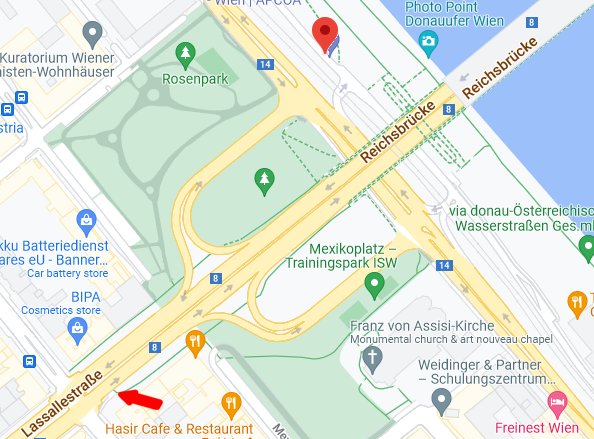
I walked as quickly as I could. There was only one opportunity to leave the sidewalk. It was a dirt path near a sign that mentioned Mexikoplatz, which I had never heard of. I walked perhaps one hundred meters farther. I then realized that there were no more opportunities to avoid crossing the bridge. So, I doubled back to the path.
Mexikoplatz was a park, not a city square. The lighting was very dim. I could obviously see the huge bridge, but I needed to slow down to watch where I was stepping. I just hoped that the path ran to the harbor, not to a fence, wall, or some other kind of barrier. If that happened, I would probably need to go back to the sidewalk and try to cross the very wide and busy street somewhere.
Eventually I did arrive at the road that ran along the dock. It was clear sailing from there until I reached the Viking ship (I forget the name) that was parked between the dock and Viking Vili. I confidently walked down the stairs and approached the door leading to the ship's reception desk. The doors did not open, and I could not see anyone at the desk. I knocked on the glass door, and to my great relief, someone quickly came and opened the door for me. I asked if this was how to enter Viking Vili. He pointed to the door on the other side, and I checked back into the ship at 11:20.
I don't know when the ship set sail, but at midnight I noticed that we were moving pretty rapidly. We must have left before the 11:55 time that Skyla had provided me on Thursday.
Before I went to sleep I sent an email to Sue describing the day's adventures. It took me three days, but I had finally accomplished something.
[1] Verizon billed us $16.11 for this call. I had not bothered to investigate the charges for phone usage on the trip. The only person who ever called me was Sue, and I expected to be with her for the entire period.
[2] Yes, I suppose that I could have saved the directions on my phone, but then I would have had two things saved. I did not trust my ability to do that. After all, I had only had the phone for four years.
[3] The notes complain that the fingers on my left hand often pressed down too hard on the keys and produced double letters. The biggest offender was the e key.

